If you are on Falzarego pass and want to get to Lagazuoi hut above it, you have various options to do so. Here I describe the Kaiserjäger ferrata, so keep reading.
Kaiserjäger ferrata (Kaiserjägersteig, Kaiserjäger path) is an easy ferrata tour in an area with incredible history. The route is named after the Austrian soldiers regiment who built it and fought against the Italians on Mt. Lagazuoi, during the First World War. You can climb it either by starting from Falzarego pass or Valparola pass. Plan up to two hours for ascent.
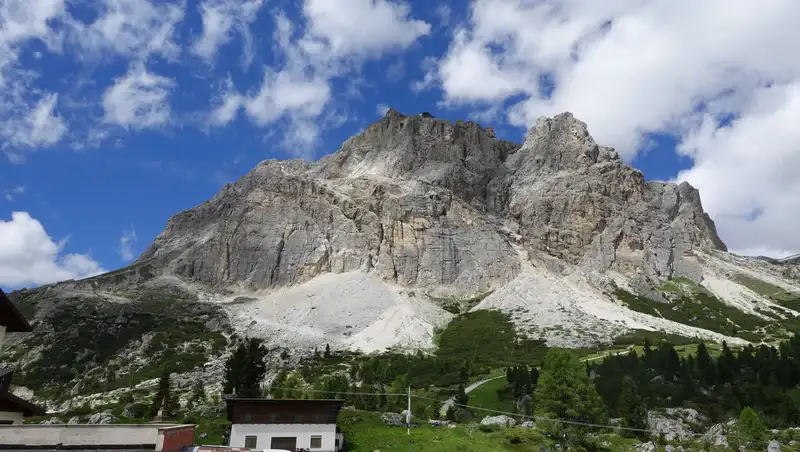
Coordinates, numbers & details
- Lagazuoi hut elevation: 2752 m (9029 ft).
- Lagazuoi hut coordinates: 46.5277717 N, 12.0082128 E.
- Route difficulty: easy ferrata.
- Useful map: Tabacco number 03, Cortina d’Ampezzo e Dolomiti Ampezzane. 1:25000.
- Free parking at Falzarego pass 2105 m (6906 ft), and at Valparola pass (2168 m; 7113 ft).
- Elevation difference from the Falzarego parking: 647 m (2123 ft).
- Time needed to the summit: 2 hours.
Lagazuoi history, access roads & location
The Mount Lagazuoi area which you see in the top picture above is like a Swiss cheese, full of tunnels and man-made caves. This is a part of Austro-Hungarian and Italian defensive lines from WW1, that are at some places separated only 50 meters or so.
The Kaiserjäger path is one out of many, and it was built by the Austro-Hungarian troops as a safe access from the Valparola pass to the upper trenches and emplacements on the summit of Mt. Lagazuoi.
Nowadays, this area is a part of the Italian Alps and the mountain range is called Dolomites, in Belluno province, but for the Austro-Hungarians this was South Tyrol (Südtirol).
The path was used by soldiers for several years, and it included a long suspension bridge, which is still there, or at least its newer version.
The mentioned tunnels were built from both sides, Italians drilled them in the rock of the south walls of the mountain, and Austrians from the north and west sides.
There is a whole Lagazuoi site devoted to the history of this amazing place. Lots of fortifications details you can see in the video:
From what I have seen and experienced in my many visits to the area, this is the most crowded spot in the Dolomites. Three roads converge here, and there are many other attractions in the area.
There is a cable car that can take you to the top in a few minutes, and many visitors use this and then explore tunnels and descend by walking back.
In addition, the popular Alta Via 1 goes here, and the Lagazuoi hut is one of the places where hikers sleep. In fact, this is the highest point of the Alta Via 1 route.
In the interactive map below you can see all the routes to the summit, just zoom in to see the details. The markers 1 and 2 on the map show Falzarego pass and Valparola pass, respectively. The marker 3 shows the position of Lagazuoi hut. If you zoom out, you will see all access roads.
But if you are not familiar with the area, if you come by car, the places that should be your destinations are San Cassiano in the north-west, Pieve in the south-west, and Cortina d’Ampezzo in the east. They are on the mentioned three roads, and you will see them in the map.
Finding a parking
There is lots of free space around to park the car, and this applies to both Falzarego pass and Valparola pass. The former is also the lift station place, and there is a paid parking next to the station.
But this is an incredibly popular place and if you come late in the morning it will be hard to find a place. Bear this in mind to avoid long walk along the road if you are forced to park far from any of the two passes.
The road in the direction of Cortina will always be far more crowded because of other places, like Cinque Torri, that attract many visitors.
In principle, far more free parking space is always available around Valparola pass, and your start point from there is also at a bit higher elevation.
Route description
The paths from both passes merge at a point which you will see in the map above. From Falzarego pass you start behind the lift station and walk first in the north direction and then in the north-west direction under the cliffs above. Below you can see how this part looks.
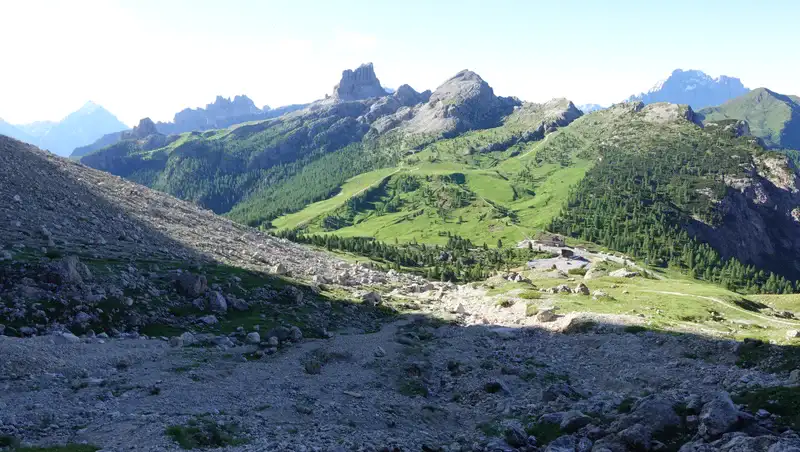
After that the path makes a loop to the east and then in the north-west direction all the way to the top. The ferrata starts from the suspension bridge which you have to cross, this is where I put my climbing harness on.
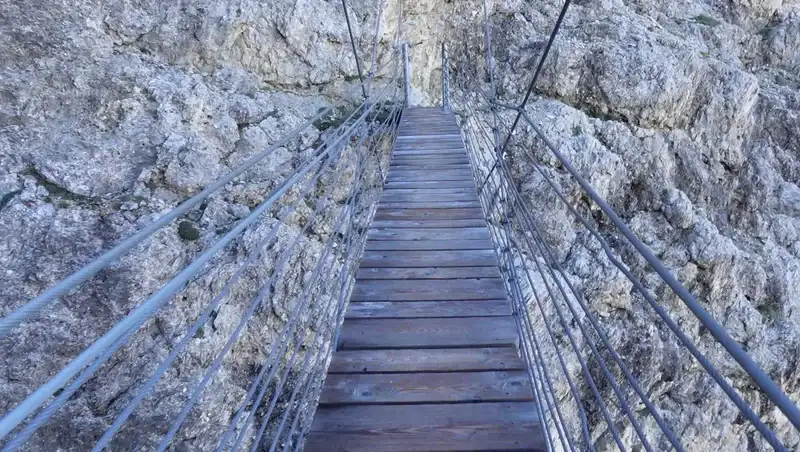
There are just a few sections with cables, and those are easy to navigate, you can do this even without ferrata equipment. Below is one spot with a few military caves and cables.
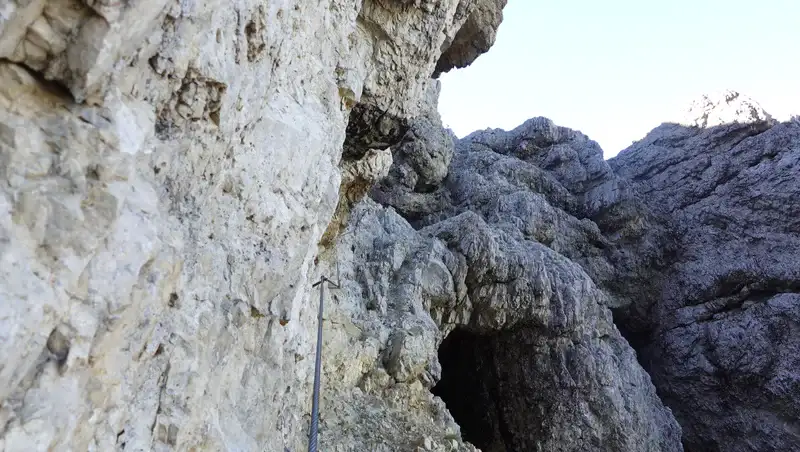
This is the view of the first tunnel built by Austrians with military caves inside:
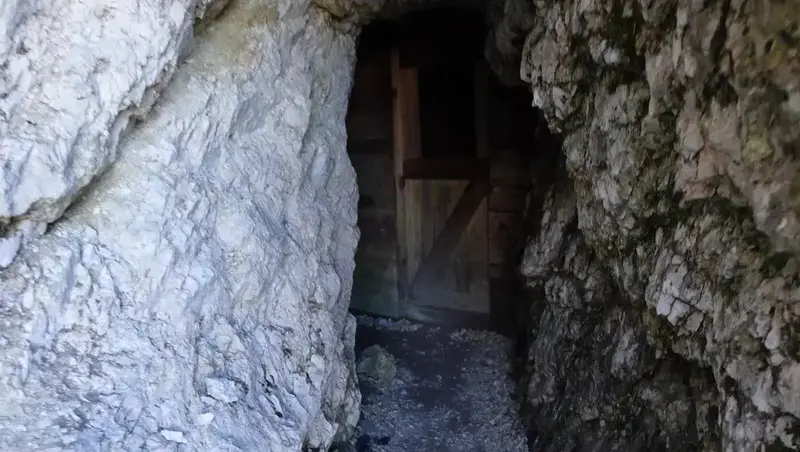
The picture below shows the point which is far above the ferrata, and this is the first view of the hut.
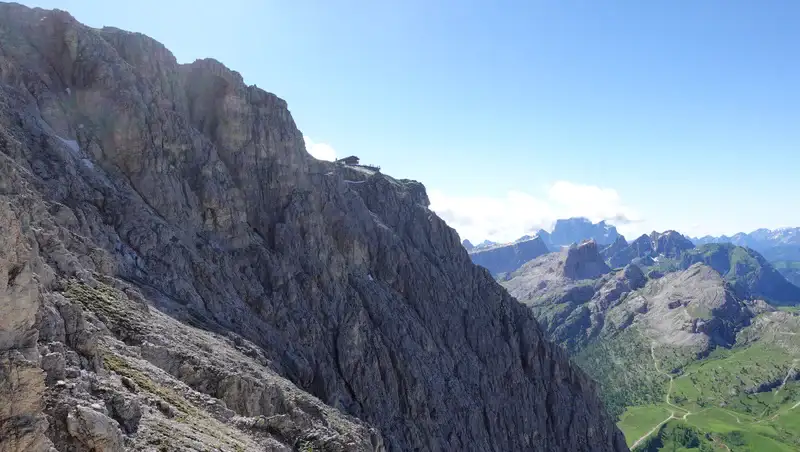
From this part you can still see the Falzarego pass. It is visible in the picture below, together with the road to Pieve valley on the right. The other road in the right bottom corner goes to the nearby Valparola pass.
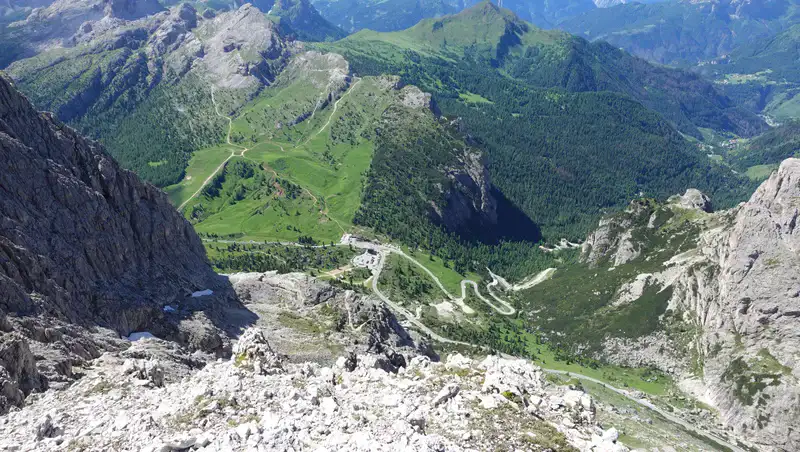
The summit area is very wide and pleasant. There were many people around, at the moment when I arrived there, the lift was working and visitors were coming from the lift station in huge numbers.
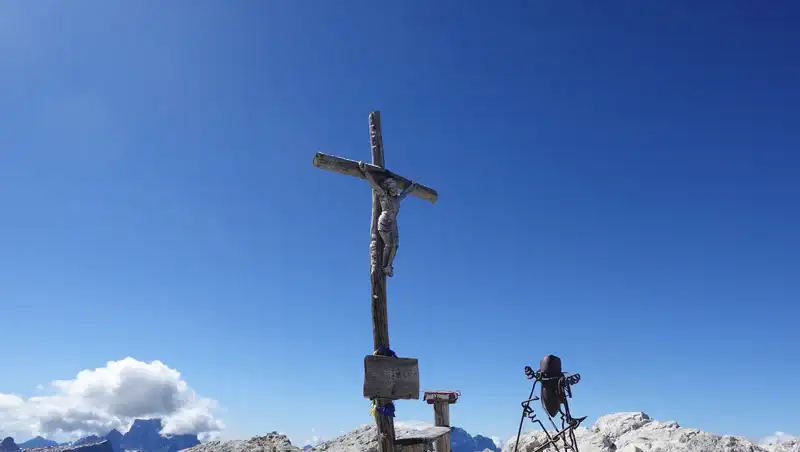
This is a bridge built for tourists, not to mix with the military bridge on the cliffs below:
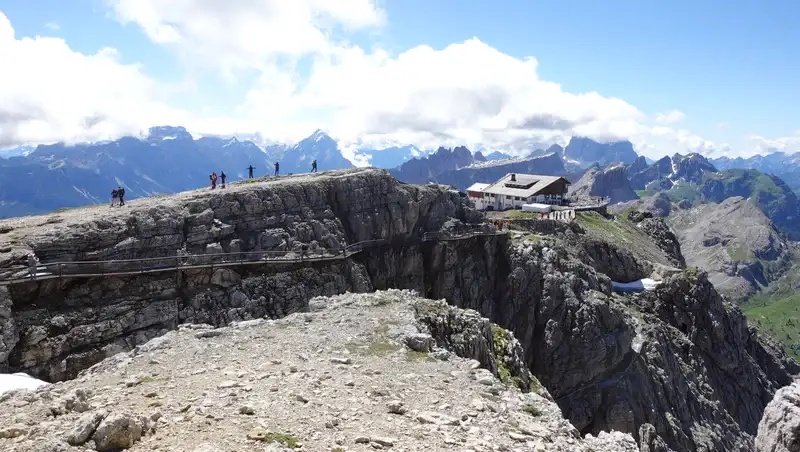
Tofane peaks dominate the views in the east direction, these mountains look impressive from every possible angle:
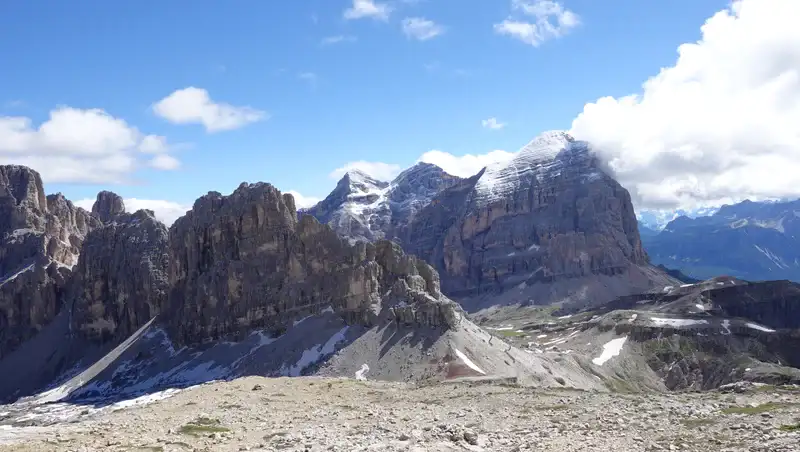
The Lagazuoi hut in early morning as visitors are coming from the nearby lift station:
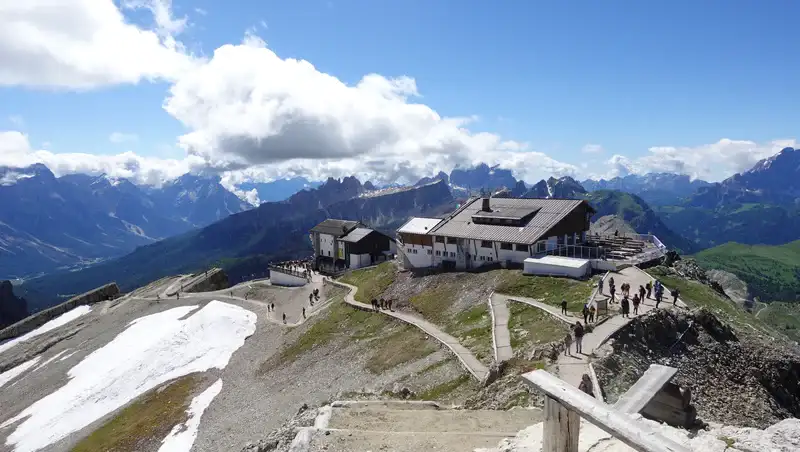
Lagazuoi hut contact details:
- Loc. Lagazuoi.
- I-32043 Cortina d’Ampezzo – BL.
- Phone and Fax +39 0436 867303 – Mobile +39 340 7195306.
- Email: info@rifugiolagazuoi.com
- https://rifugiolagazuoi.com/
My climb
I started from Falzarego pass at 7:40 AM, and I was on the summit exactly two hours later. There were several larger groups moving up, both from my side and from passo Valparola.
The summit and hut area were also crowded, lift was working. I would say that during the day there were many hundreds of people around, my descend route included.
Before the climb, I changed the backpack and moved things that I normally always have in its pockets, but I missed to take a torch with me. I realized my big mistake when I wanted to explore some of numerous tunnels and galleries.
So make sure that you do not make such a terrible mistake, or you will miss to see a lot of stuff that makes this area so popular. This is a true open-air museum, and I have seen a statement that all the tunnels are kilometers long in total.
Nevertheless, I entered a few tunnels below the lift station, here are a few pictures from two different tunnels:
I decided to make this a round tour so continued towards Forcella Lagazuoi and then to Forcella Travenazes. The picture below is from the latter.
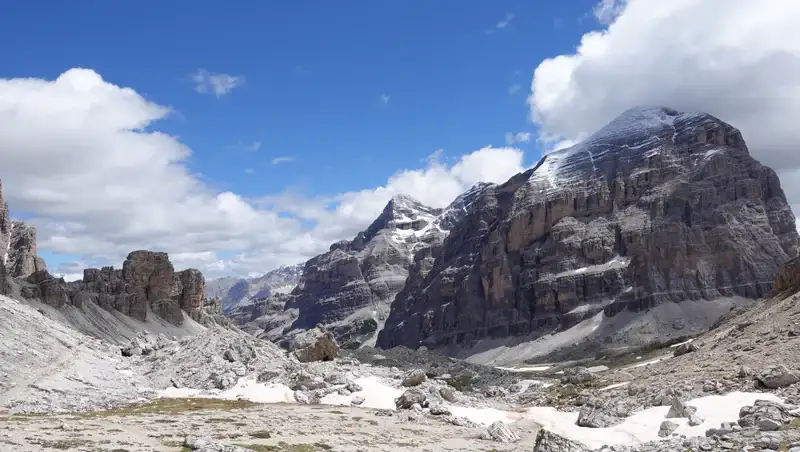
What you see is Tofana di Rozes, and behind you see the other two peaks, Tofana di Mezzo, and Tofana di Dentro. I have climbed them all, and if you need any information do let me know in the comment box below.
Below is one more picture from my descent, and you see people going in the direction of the cliffs where there is yet another ferrata that you can use to get to the summit. This is the part of the mountain that was in hands of Italians during WW1, so fortifications and tunnels on this side are built by them.
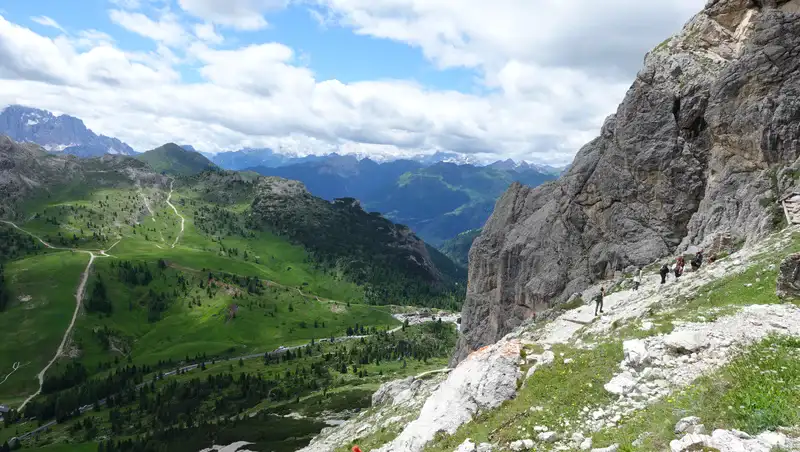
You can see more about the tour in my video:
My rating of the Kaiserjäger ferrata
This is an easy ferrata, but I have 8 rating criteria, so see how it stands:
| Rating Criteria | Rating (1-10) |
|---|---|
| Scenic Beauty | 9 |
| Difficulty* | 1 |
| Route Condition | 10 |
| Accessibility | 9 |
| Crowd Levels** | 1 |
| Historical Interest | 10 |
| Support Facilities | 10 |
| Weather Risks and Protection | 10 |
| Overall Score | 60/80 |
*The bigger the number the heavier ferrata.
**The bigger the number the less crowded ferrata. Lagazuoi area and Falzarego pass are one of the busiest places in the Dolomites, possibly even the busiest of all.
Regarding Weather Risks and Protection, this is about options for shelters in the case of a storm, sun exposure, possible icy sections, etc. The higher number the lower risk.
Note that a part of the route is in the shade in the morning, so you have minimal sun exposure. But there was a short snow passage, this may be problem in early season.
You have already seen that caves and tunnels are on the way up, and you have the hut and lift station. So it is easy to find a shelter in the case of storm. Take the lift to get back if the weather changes to bad when you are there. But even if you decide to walk back, tunnels are around to hide from rain.
Equipment, supplies & accommodation
This was a short day tour so I used my Osprey Stratos 24 backpack. The boots were Mammut Sapuen GTX. and I also had all ferrata equipment that includes a climbing Petzl helmet, a harness, and a Y-rope.
None of these ferrata elements is essential, I had them because I did not know what to expect. You know now. But it is better to have them with you.
I also had a pair of Komperdell trekking poles.
Regarding water, directly behind the lift station at the beginning of the tour you have a place to refill. There is no water to refill at Valparola pass, but there is a hut/restaurant there too.
For food, it is up to you, you can carry it or have a lunch at the summit in the Lagazuoi hut.
The nearest food shops are on the Cassiano side, a small one is in the camping which you can easily locate on the map above. A much larger food shop is down the road just a couple of kilometers from the mentioned camping.
As for accommodation, this is about the Dolomites, so make sure you make a reservation in time.
Final thoughts
In summary, the Lagazuoi Kaiserjäger Ferrata offers a compelling combination of historical significance and natural beauty, making it a standout experience in the Dolomites.
From the WW1-era tunnels and fortifications to the sweeping views of Tofane peaks, every step of the journey is rich in discovery. The route’s manageable difficulty level ensures it’s accessible to a wide range of outdoor enthusiasts, whether they’re seasoned climbers or history buffs.
However, the popularity of the area, especially near Falzarego and Valparola passes, means early starts are essential to avoid crowds and secure parking.
Whether ascending via the ferrata or taking the cable car for a more leisurely visit, Lagazuoi is an unforgettable destination. The extensive network of trails, tunnels, and facilities like the Lagazuoi hut caters to varied interests and makes this area a true open-air museum.
Proper preparation, including carrying sufficient supplies and ferrata gear, will ensure a safe and enjoyable outing. For those who appreciate breathtaking alpine scenery and a deep connection to the past, the Kaiserjäger Ferrata is an experience not to be missed.
Thank you for reading and let me know if you have questions, there is a comment box below. For more texts about mountains in this area please check under the category Italian Alps.
Please join us at our Facebook group Dolomites Visitors Hub. Subscribe to my weakly newsletter and stay informed, the subscription form is given below.
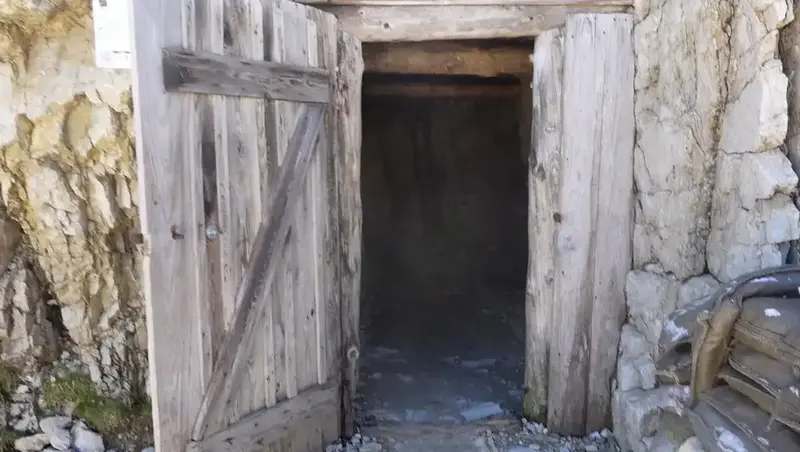
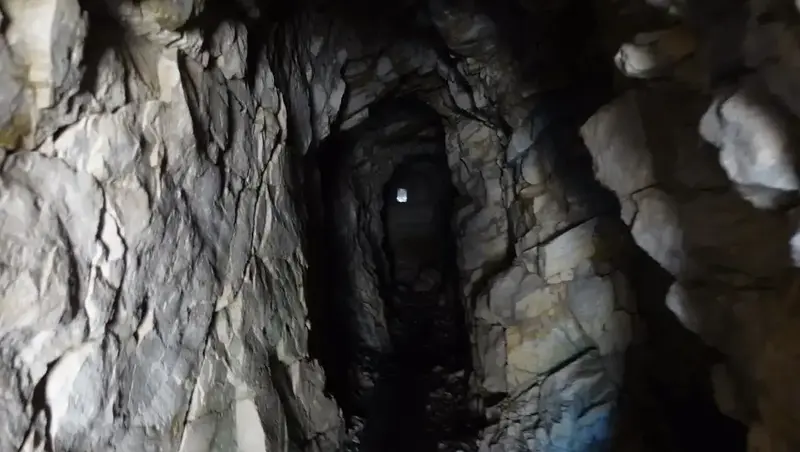
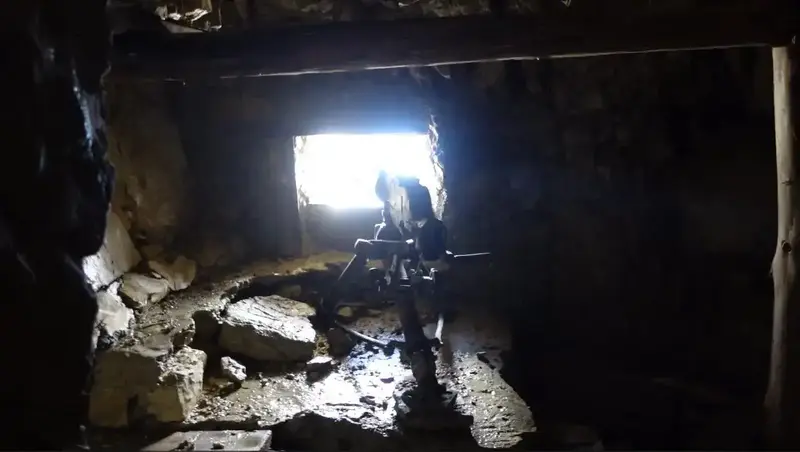
Leave a Reply